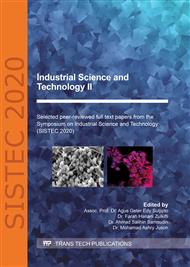[1]
A.Z. Ithnin, Forest plantation programme in Malaysia—the way forward, in Seminar and workshop on improved utilization of tropical plantation timbers. (2011) p.23.
Google Scholar
[2]
Malaysia Timber Industry Board, Eight selected species for forest plantation programme in Malaysia. Malaysia Timber Industry Board, Kuala Lumpur, Malaysia, (2007).
DOI: 10.21315/mjms2019.26.5.13
Google Scholar
[3]
A.S. Nordahlia, S.C. Lim, H. Hamdan, and U.M.K. Anwar, Wood properties of selected plantation species: Tectona grandis (teak), Neolamarckia cadamba (kelempayan/laran), Octomeles sumatrana (binuang) and Paraserianthes falcataria (batai). Timber Technology Bulletin, 54 (2014) 1-4.
DOI: 10.26525/jtfs2018.30.1.5866
Google Scholar
[4]
N. Ayrilmis, U. Buyuksari, E. Avci, and E. Koc, Utilization of pine (Pinus pinea L.) cone in manufacture of wood-based composite. Forest Ecology and Management, 259(1) (2009) 65-70.
DOI: 10.1016/j.foreco.2009.09.043
Google Scholar
[5]
J. Trischler, and D. Sandberg, Surface modification of monocotyledons as a substitute raw material for particleboards: A review. In Forest Products Society International Convention: 10/08/2014-13/08/2014, (2014).
Google Scholar
[6]
S. Vargas, J.R. Rodriquez, H.E.H. Lobland, K. Piechowicz and W. Brostow, Preparation of rice husk‐based medium density fiberboards: effects of pH modification on mechanical and tribological performance. Macromolecular Materials and Engineering, 299(7) (2014) 807-813.
DOI: 10.1002/mame.201300341
Google Scholar
[7]
M.E. Selamat, O. Sulaiman, R. Hashim, S. Hiziroglu, W.N.A.W. Nadhari, N.S. Sulaiman, and M.Z. Razali, Measurement of some particleboard properties bonded with modified carboxymethyl starch of oil palm trunk. Measurement, 53 (2014) 251-259.
DOI: 10.1016/j.measurement.2014.04.001
Google Scholar
[8]
H. Pirayesh, H. Khanjanzadeh and A. Salari, Effect of using walnut/almond shells on the physical, mechanical properties and formaldehyde emission of particleboard. Composites Part B: Engineering, 45(1) (2013) 858-863.
DOI: 10.1016/j.compositesb.2012.05.008
Google Scholar
[9]
W. Song, W. Wei, C. Ren and S. Zhang. Effect of heat treatment or alkali treatment of veneers on the mechanical properties of eucalyptus veneer / polyethylene film plywood composites. BioResources, 12(4) (2017) 8683-8703.
DOI: 10.15376/biores.12.4.8683-8703
Google Scholar
[10]
S. Hemsri, K. Grieco, A.D. Asandei and R.S. Parnas, Wheat gluten composites reinforced with coconut fiber. Composites Part A: Applied Science and Manufacturing, 43(7) (2012) 1160-1168.
DOI: 10.1016/j.compositesa.2012.02.011
Google Scholar
[11]
C. Qi, K. Guo and Y. Liu, Preparation and properties of cotton stalk bundles and high-density polyethylene composites using hot-press molding. Journal of Reinforced Plastics and Composites, 31(15) (2012) 1017-1024.
DOI: 10.1177/0731684411435726
Google Scholar
[12]
S.K. Acharya, P. Mishra and S.K. Mehar, Effect of surface treatment on the mechanical properties of bagasse fiber reinforced polymer composite. BioResources, 6(3) (2011) 3155-3165.
Google Scholar
[13]
X. Li and G. Du, Influence of NaOH treatment on the mechanical properties of particleboard. Materials Research Innovations, 19(sup8) (2015) S8-630.
DOI: 10.1179/1432891715z.0000000001761
Google Scholar
[14]
Technical Association of the Pulp and Paper Industry (TAPPI), Sampling and preparing wood for analysis (T257 cm-02). Technical Association of the Pulp and Paper Industry, Atlanta, GA, (2002).
DOI: 10.2524/jtappij1947.1.2_36
Google Scholar
[15]
B. Doczekalska and M. Zborowska, Wood chemical composition of selected fast-growing species treated with NaOH Part I: structural substances. Wood Res, 55 (2010) 41-48.
Google Scholar
[16]
C.B. Vick, Adhesive bonding of wood materials. Wood handbook: wood as an engineering material. Madison, WI: USDA Forest Service, Forest Products Laboratory, 1999. General technical report FPL, GTR-113: (1999) 9.1-9.24.
DOI: 10.2737/fpl-gtr-113
Google Scholar
[17]
M. Le Troedec, D. Sedan, C. Peyratout, J.P. Bonnet, A. Smith, R. Guinebretiere and P. Krausz, Influence of various chemical treatments on the composition and structure of hemp fibres. Composites Part A: Applied Science and Manufacturing, 39(3) (2008) 514-522.
DOI: 10.1016/j.compositesa.2007.12.001
Google Scholar
[18]
H. Pirayesh and A. Khazaeian, Using almond (Prunus amygdalus L.) shell as a bio-waste resource in wood-based composite. Composites Part B: Engineering, 43(3) (2012) 1475-1479.
DOI: 10.1016/j.compositesb.2011.06.008
Google Scholar
[19]
H. Pirayesh, A. Khazaeian and T. Tabarsa, The potential for using walnut (Juglans regia L.) shell as a raw material for wood-based particleboard manufacturing. Composites Part B: Engineering, 43(8) (2012) 3276-3280.
DOI: 10.1016/j.compositesb.2012.02.016
Google Scholar
[20]
S.K. Shaha, S. Dyuti, Q. Ahsan and M. Hasan, Effect of alkali treatment on surface morphology and properties of jute yarns. In Advanced Materials Research, 264 (2011) 1922-1927.
DOI: 10.4028/www.scientific.net/amr.264-265.1922
Google Scholar
[21]
C. Albano, M. Ichazo, J. González, M. Delgado and R. Poleo, Effects of filler treatments on the mechanical and morphological behavior of PP+ wood flour and PP+ sisal fiber. Materials Research Innovations, 4(5-6) (2001) 284-293.
DOI: 10.1007/s100190000108
Google Scholar
[22]
B.S. Ndazi, C.W. Nyahumwa and J. Tesha, Chemical and thermal stability of rice husks against alkali treatment. BioResources, 3(4) (2008) 1267-1277.
Google Scholar
[23]
C. Mancera, F. Ferrando and J. Salvado, Cynara cardunculus as raw material for the production of binderless fiberboards: Optimization of pretreatment and pressing conditions. Journal of wood chemistry and technology, 28(3) (2008) 207-226.
DOI: 10.1080/02773810802347024
Google Scholar
[24]
S. Yasar and B. İçel, Alkali modification of cotton (Gossypium hirsutum L.) stalks and its effect on properties of produced particleboards. BioResources, 11(3) (2016) 7191-7204.
DOI: 10.15376/biores.11.3.7191-7204
Google Scholar
[25]
D.J. Sundquist and D.S. Bajwa, Dried distillers' grains with soluble as a multifunctional filler in low density wood particleboards. Industrial Crops and Products, 89 (2016) 21-28.
DOI: 10.1016/j.indcrop.2016.04.071
Google Scholar
[26]
M. Tajuddin, Z. Ahmad and H. Ismail, A review of natural fibers and processing operations to produce binderless boards. BioResources, 11(2) (2016) 5600-5617.
DOI: 10.15376/biores.11.2.tajuddin
Google Scholar
[27]
R. Punyamurthy, D. Sampathkumar, C.V. Srinivasa and B. Bennehalli, Effect of alkali treatment on water absorption of single cellulosic abaca fiber. BioResources, 7(3) (2012) 3515-3524.
DOI: 10.7598/cst2013.371
Google Scholar
[28]
J.C. Mejía Osorio, R. Rodríguez Baracaldo and J.J. Olaya Florez, The influence of alkali treatment on banana fibre's mechanical properties. Ingeniería e investigación, 32(1) (2012) 83-87.
DOI: 10.15446/ing.investig.v32n1.28524
Google Scholar
[29]
K.C.C. Carvalho, D.R. Mulinari, H.J.C. Voorwald and M.O.H. Cioffi, Chemical modification effect on the mechanical properties of hips/coconut fiber composites. BioResources, 5(2) (2010) 1143-1155.
Google Scholar


